Reuters exclusively reported that Volkswagen has walked away from talks with Renault to jointly develop an affordable electric version of the Twingo car, in a setback for the EU carmakers’ efforts to fend off Chinese rivals.
News
Fear and tension in Lebanon under deadly Israeli bombardment
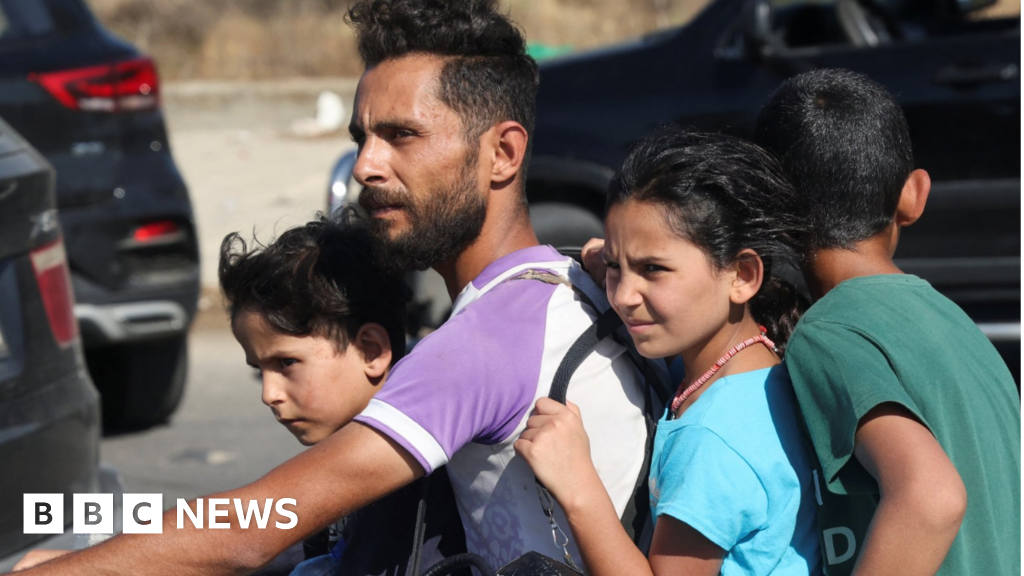
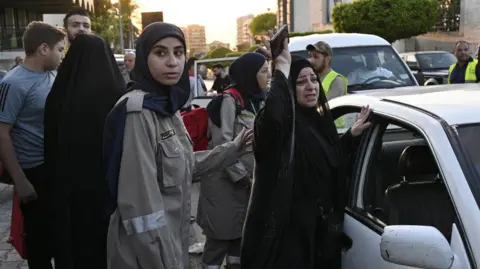 EPA
EPAAcross southern Lebanon, families scrambled together belongings and headed north in cars and trucks and on motorcycles as the Israeli military struck targets it said were linked to the Lebanese Shia armed group Hezbollah.
Some residents reported receiving warnings in the form of text messages and voice recordings from the Israeli military to leave areas near the Iran-backed group’s positions.
Zahra Sawli, a student in the southern town of Nabatieh told the BBC’s Newshour programme the bombardment was intense.
“I woke up at 6am to the sound of bombing. By noon it started to get really intense and I saw a lot of strikes in my area.”
“I heard a lot of glass shattering.”
Unlike many, she and those she was with did not leave the house – they didn’t dare, she said.
“Where are we supposed to go? A lot of people are still stuck on the streets. A lot of my friends are still stuck in traffic because a lot of people are trying to flee,” she said.
By the middle of the day roads north towards Beirut were clogged with traffic, with vehicles heading towards the capital on both sides of a six-lane coastal highway.
Other images showed people walking along the beach in the southern city of Tyre as smoke rose from air strikes in the countryside inland.
The BBC spoke to one family of five who had arrived in Beirut on a single motorbike.
From a village in the south, they were heading to Tripoli in the north. They were exhausted.
“What do you want us to say? We just had to flee,” the father said.
 Hassan Harfoush
Hassan HarfoushBy Monday evening the Lebanese health ministry reported that 492 people had been killed and more than 1,600 injured in the bombardment. It said at least 35 children were among those killed. The Israel Defense Forces (IDF) said it had carried out 1,100 strikes over the previous 24 hours.
That included an air strike in southern Beirut that the IDF said had targeted a senior Hezbollah commander.
In Beirut too there was widespread anxiety. As people from the south arrived in the capital in cars with suitcases strapped to the top, some of the city’s residents were themselves leaving.
Israel has warned people to evacuate areas where it says Hezbollah is storing weapons – but it also sent recorded warnings to people in Beirut districts not considered Hezbollah strongholds including Hamra, an area home to government ministries, banks and universities.
Parents rushed to pick up their children from school after receiving more warnings to leave the area.
One father, Issa, took his son out of school, telling Reuters news agency: “[We’re here] because of the phone calls.
“They’re calling everyone and threatening people by phone. So we’re here to take my boy from school. The situation is not reassuring,” he said.
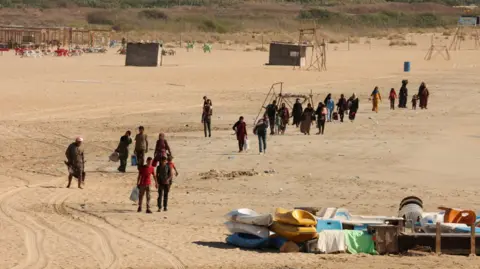 Reuters
ReutersMohammed, a Palestinian man on the road with his wife, spoke to the BBC on the way out of Beirut.
When asked if he would stay in the capital he said: “In Lebanon nowhere is safe, Israel is saying they are going to bombard everywhere. Now they threatened this neighbourhood, so where should we go?”
“It’s scary, I don’t know what to do – work, go home, no idea what to do.”
Meanwhile as a BBC crew set up on one side of the road, a taxi driver called out asking if they knew of a fuel crisis unfolding. “Too many people are coming to Beirut,” he said.
Schools have been hastily converted into shelters for the streams of evacuees coming from the south. On a government order, schools in Beirut and Tripoli as well as eastern Lebanon were established as shelters.
The BBC was at a classroom at a public school in Bir Hasan, west Beirut on Monday which was being prepared for people coming from the Bekaa Valley – a Hezbollah stronghold in north-eastern Lebanon which Israel said it was targeting too.
The classrooms were stacked with mattresses but would be fully occupied by the end of the day, workers said.
 EPA
EPAMeanwhile Lebanon’s hospitals were also ordered to cancel all non-elective surgeries on Monday as physicians braced for a wave of casualties and injuries.
Despite the tense and uncertain atmosphere in Beirut, some people were defiant.
“If a total war happens, we should stand as Lebanese people together regardless of our political affiliations because at the end of the day, our country is getting bombed,” one man told the BBC.
Others were simply resigned to the violence.
“If they want war, what can we do? It was imposed on us. We cannot do anything,” shop owner Mohammed Sibai told Reuters.
Mohammed, a 57-year-old in the southern Beirut suburb of Dahieyh – Hezbollah’s main power base in the capital – told the BBC he had “survived all the wars since 1975” so “it’s normal for me”.
“I will not leave, I will be in my house,” he said.
News
Kamala Harris Surges Ahead of Donald Trump in New Polls


Raised $27 million
In an impressive fundraising effort, Harris raised $27 million at a recent event in New York, signaling her strong financial backing as the campaign progresses. She is expected to deliver a speech on the economy this week, further outlining her vision for America.
In contrast, Trump is reluctant to participate in further debates, particularly one proposed by CNN. He claims that the timing is not favorable, as early voting has already begun in many states.
“The issue with another debate is that it’s too late. She had her chance to debate on Fox, but now she wants a CNN debate because she is losing,” Trump remarked, reflecting his strategy to focus on rallies rather than televised confrontations.
As early voting continues across the country, with only three states — Alabama, Mississippi, and New Hampshire — prohibiting in-person early voting, the dynamics of the race could shift dramatically in the coming weeks.
Trump has also indicated that if he loses this election, he may not run again, adding to the stakes of the current political climate.
Business
VW and Renault end talks to develop affordable EV

Automotive
17 May 2024, 10:01 am 1 minute
Market Impact
A potential partnership between Volkswagen and Renault would have brought together household names of Europe’s top two economies and formed a counterweight against Asian rivals muscling into the local market.
Article Tags
Topics of Interest: Automotive
Type: Reuters Best
Sectors: Transport & Logistics
Regions: Europe
Win Types: Exclusivity
Story Types: Exclusive / Scoop
Media Types: Text
Customer Impact: Important Regional Story
News
Woman and eight-year-old girl found dead in Salford house


An eight-year-old girl and a woman have been found dead at a property in Salford.
Officers were called following reports of a concern for welfare at the property in South Radford Street, Salford, shortly after 10.30am on Monday, Greater Manchester Police said.
Both the child and the woman, 40, were found dead at the scene after assistance from North West Ambulance Service and Greater Manchester Fire and Rescue Service.
The force said it was not actively looking for anyone else in the investigation and that there was no wider threat in the community.
All known next of kin have been informed and are being supported by specialist officers.
Detective Superintendent Simon Moyles said: “A woman and young girl were both tragically found dead and we are working hard as a team to establish what happened here this morning.
“We have placed a number of highly visible officers to patrol in and around the area should any residents wish to come and talk to us or pass on any information they may have about this tragic incident.”
Anyone with information on the incident has been asked to call 101 quoting log 998 of 23/09/2024.
Business
The challenge of preserving coastal forests

 Vishal Jaiswal
Vishal JaiswalVishal Jaiswal has been flying drones since he was young.
Now 27, that childhood hobby has become his profession. A recent project involved mapping part of the Sundarbans, a vast area of mangrove forests where the waters of the Ganges, Brahmaputra and Meghna rivers spill into the Bay of Bengal.
Covering more than 4,000 sq miles (10,360 sq km) of coastal India and Bangladesh, it is the world’s biggest area of mangroves.
“It’s a very dense area with mix of everything, including forests with wild animals,” says Mr Jaiswal.
Along with two other team members he mapped 150 sq km in three days.
“A trained and skilled person is needed to fly a drone in thick mangroves area,” he says.
“It was a difficult task. We mapped the area from deep inside the forest, travelling there on boats and roads.”
It was one of many projects aimed at protecting the mangrove forest from the effects of climate change and human activities.
Globally, more than half of all mangrove ecosystems are at risk of collapse by 2050, according to a recent report from the International Union for Conservation of Nature (IUCN).
“Mangroves are threatened by deforestation, development, pollution, and dam construction, but the risk to these ecosystems is increasing due to sea-level rise and the increased frequency of severe storms associated with climate change,” the report said.
In India the picture is mixed.
The mangroves of South India, Sri Lanka and Maldives are “critically endangered,” according to the IUCN report.
 Getty Images
Getty ImagesOther Indian mangroves are not on that “red list”.
The Sundarbans are one of those mangroves not considered endangered by the (IUCN).
However, Dr Sahadev Sharma, a consultant scientist to the USDA Forestry Service, says there are signs of both manmade and natural stress, which he identified during his field survey beginning of this year.
“We are seeing a loss in dense mangrove cover in Sundarbans. Additionally, patches on the western coast are extremely fragmented and eroded due to shrimp farming and development,” he says.
But it’s hard for scientists to know exactly what’s happening to the Sundarbans. There’s a lack of field research, partly because it’s a difficult place to work.
“It requires coordination with officers and ground staff, procuring field supplies in remote areas, and planning extensive logistics for field operations.
“The risk of saltwater crocodiles and Bengal tigers, tides and treacherous terrain make the field work even more difficult,” he says.
So, scientists are turning to tech, like Mr Jaiswal’s drones, to monitor the mangroves.
One key bit of information needed is the height of the mangroves in relation to the sea level.
The rivers flooding into the Sundarbans dump sediment, raising the ground level.
But if the sea level rises faster than that soil building process, then the mangroves will be threatened.
This process is monitored by installing rSETs (rod surface elevation tables) across mangrove forests.
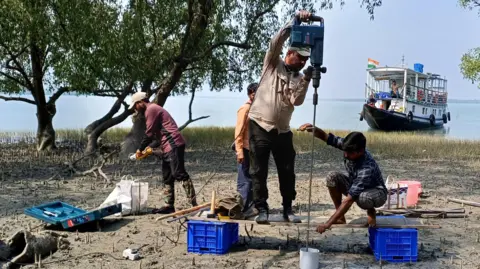 Sahadev Sharma
Sahadev SharmaThe first part of the process is to drive steel rods into the mud, to provide a base for the measuring equipment.
Then Lidar scanners are attached to the top of the rods. These use lasers to scan the ground up to 2m away from the central rod, taking hundreds of thousands of extremely accurate measurements.
It’s a big improvement on the previous system, which involved attaching cumbersome fibreglass arms to the rods, which were extended to take height measurements.
That method would take hours to produce just 36 measurements and relied on the user placing the arms in the exact same positions as previous surveys.
“Because we are using a laser, there is minimal human error and the precision of this method is much greater than the traditional pin methods,” says Mr Sharma.
But it has one drawback – it’s more expensive than the old way.
Nevertheless, the project is making progress with the help of local partners.
Measuring sites are in place in the Andaman Islands, Sundarbans and Coringa and there are plans to install more in Bhitarkanika National Park, Orissa.
The research is still in its early days, they have a few data sets, but are waiting for the water level to recede before they can start measuring in the Sundarbans.
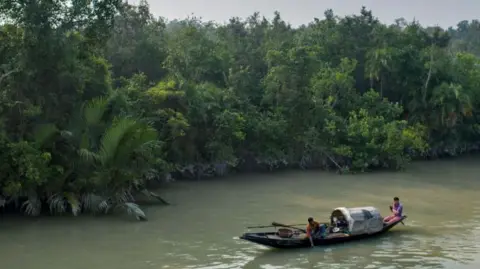 Getty Images
Getty ImagesMany who live in the coastal regions that support mangrove forests rely on them for survival.
In Andhra Pradesh, which has a long coastline in eastern India, fisherman Laxman Anna blamed the destruction of mangroves for poor catches.
“A few years back it had become a frustrating job. Going into the creek to catch fish and coming back empty handed.”
“Imagine a day when I made just 60 cents for my entire day in the creek, as there were no fishes. Barely enough to sustain my family of five.”
He blamed shrimp farms for upsetting the ecosystem.
But Mr Anna says communities in his area have realised the importance of preserving the mangroves.
“We are planting saplings, nurturing them back to life with help of an NGO and the forest department.”
And that effort is paying off.
“Things are changing I have a smile on my face when I go to fishing now. I am able to get a good catch and make around seven to eight dollars a day, which is a good catch for my survival.”
News
Jane McDonald left speechless after BBC The One Show host's 'C-word' slip-up


Singer and TV presenter Jane McDonald appeared on The One Show on Monday night and was left in hysterics after a slip-up from presenter Alex Jones.
Business
Generation X Germans may be last to enjoy Europe’s dolce vita
As an American-German family living on both sides of the Atlantic, I must sadly agree with Janan Ganesh’s assessment in his characteristically insightful article “Why Europe will not catch up with the US” (Opinion, September 19). He captures the core issues with precision. However, I find myself even more pessimistic about Germany’s ability to preserve the European “dolce vita” beyond Generation X.
The challenges facing Germany are multi-faceted. Entrepreneurs here continue to struggle with a lack of support and access to funding, which stifles innovation and economic growth. Despite the growing need for modernised industries and fresh ideas, the “old boys’ club” mentality persists, keeping power concentrated in the hands of the traditional elite. This resistance to change is not just limiting entrepreneurship but also the ability of Germany to adapt in a rapidly evolving global economy. Moreover, the country’s education system is underfunded, leaving younger generations with fewer opportunities to compete in a highly skilled, global workforce.
At the same time, the burden on the social welfare system is at an all-time high, with a worrying trend that many welfare recipients and their offspring may remain dependent on state support. This situation risks creating a growing divide between those who contribute to the system and those who rely on it, further hampering economic progress.
My 20-year-old, who sees these issues first-hand, recently commented that if things continue this way, she may reluctantly move back to the US — a decision she views as a last resort.
It’s a sentiment I hear echoed more often by young people in Germany, and it’s deeply concerning for the country’s future.
Alka Schumacher
Cologne, Germany
-

 Womens Workouts5 hours ago
Womens Workouts5 hours ago3 Day Full Body Women’s Dumbbell Only Workout
-

 News5 days ago
News5 days agoYou’re a Hypocrite, And So Am I
-

 Sport4 days ago
Sport4 days agoJoshua vs Dubois: Chris Eubank Jr says ‘AJ’ could beat Tyson Fury and any other heavyweight in the world
-

 News1 day ago
News1 day agoOur millionaire neighbour blocks us from using public footpath & screams at us in street.. it’s like living in a WARZONE – WordupNews
-

 Technology6 days ago
Technology6 days agoWould-be reality TV contestants ‘not looking real’
-

 Science & Environment5 days ago
Science & Environment5 days agoHow to unsnarl a tangle of threads, according to physics
-

 Science & Environment4 days ago
Science & Environment4 days ago‘Running of the bulls’ festival crowds move like charged particles
-

 CryptoCurrency4 days ago
CryptoCurrency4 days agoEthereum is a 'contrarian bet' into 2025, says Bitwise exec
-

 CryptoCurrency4 days ago
CryptoCurrency4 days agoDZ Bank partners with Boerse Stuttgart for crypto trading
-
Travel1 day ago
Where Retro Glamour Meets Modern Chic in Athens, Greece
-

 Science & Environment5 days ago
Science & Environment5 days agoWhy this is a golden age for life to thrive across the universe
-

 Science & Environment5 days ago
Science & Environment5 days agoQuantum ‘supersolid’ matter stirred using magnets
-

 Science & Environment5 days ago
Science & Environment5 days agoSunlight-trapping device can generate temperatures over 1000°C
-

 Health & fitness6 days ago
Health & fitness6 days agoThe secret to a six pack – and how to keep your washboard abs in 2022
-

 Science & Environment5 days ago
Science & Environment5 days agoLiquid crystals could improve quantum communication devices
-

 CryptoCurrency4 days ago
CryptoCurrency4 days agoBitcoin miners steamrolled after electricity thefts, exchange ‘closure’ scam: Asia Express
-

 CryptoCurrency4 days ago
CryptoCurrency4 days agoCardano founder to meet Argentina president Javier Milei
-

 CryptoCurrency4 days ago
CryptoCurrency4 days agoDorsey’s ‘marketplace of algorithms’ could fix social media… so why hasn’t it?
-

 CryptoCurrency4 days ago
CryptoCurrency4 days agoLow users, sex predators kill Korean metaverses, 3AC sues Terra: Asia Express
-

 CryptoCurrency4 days ago
CryptoCurrency4 days agoBitcoin bulls target $64K BTC price hurdle as US stocks eye new record
-

 News4 days ago
News4 days agoIsrael strikes Lebanese targets as Hizbollah chief warns of ‘red lines’ crossed
-

 Science & Environment4 days ago
Science & Environment4 days agoHyperelastic gel is one of the stretchiest materials known to science
-

 Science & Environment5 days ago
Science & Environment5 days agoMaxwell’s demon charges quantum batteries inside of a quantum computer
-

 Science & Environment5 days ago
Science & Environment5 days agoQuantum forces used to automatically assemble tiny device
-

 News4 days ago
News4 days agoBrian Tyree Henry on voicing young Megatron, his love for villain roles
-

 Science & Environment5 days ago
Science & Environment5 days agoITER: Is the world’s biggest fusion experiment dead after new delay to 2035?
-

 Science & Environment5 days ago
Science & Environment5 days agoHow to wrap your mind around the real multiverse
-

 Science & Environment5 days ago
Science & Environment5 days agoPhysicists are grappling with their own reproducibility crisis
-

 Science & Environment5 days ago
Science & Environment5 days agoNuclear fusion experiment overcomes two key operating hurdles
-

 CryptoCurrency4 days ago
CryptoCurrency4 days agoRedStone integrates first oracle price feeds on TON blockchain
-

 CryptoCurrency4 days ago
CryptoCurrency4 days agoSEC asks court for four months to produce documents for Coinbase
-

 CryptoCurrency4 days ago
CryptoCurrency4 days agoVitalik tells Ethereum L2s ‘Stage 1 or GTFO’ — Who makes the cut?
-

 CryptoCurrency4 days ago
CryptoCurrency4 days agoBlockdaemon mulls 2026 IPO: Report
-

 Science & Environment1 day ago
Science & Environment1 day agoMeet the world's first female male model | 7.30
-

 Sport4 days ago
Sport4 days agoUFC Edmonton fight card revealed, including Brandon Moreno vs. Amir Albazi headliner
-

 Technology4 days ago
Technology4 days agoiPhone 15 Pro Max Camera Review: Depth and Reach
-

 Science & Environment4 days ago
Science & Environment4 days agoHow one theory ties together everything we know about the universe
-

 Science & Environment5 days ago
Science & Environment5 days agoLaser helps turn an electron into a coil of mass and charge
-

 Science & Environment5 days ago
Science & Environment5 days agoQuantum time travel: The experiment to ‘send a particle into the past’
-

 CryptoCurrency4 days ago
CryptoCurrency4 days ago2 auditors miss $27M Penpie flaw, Pythia’s ‘claim rewards’ bug: Crypto-Sec
-

 CryptoCurrency4 days ago
CryptoCurrency4 days agoJourneys: Robby Yung on Animoca’s Web3 investments, TON and the Mocaverse
-

 CryptoCurrency4 days ago
CryptoCurrency4 days ago$12.1M fraud suspect with ‘new face’ arrested, crypto scam boiler rooms busted: Asia Express
-

 CryptoCurrency4 days ago
CryptoCurrency4 days agoCertiK Ventures discloses $45M investment plan to boost Web3
-

 CryptoCurrency4 days ago
CryptoCurrency4 days agoVonMises bought 60 CryptoPunks in a month before the price spiked: NFT Collector
-

 CryptoCurrency4 days ago
CryptoCurrency4 days ago‘Silly’ to shade Ethereum, the ‘Microsoft of blockchains’ — Bitwise exec
-

 CryptoCurrency4 days ago
CryptoCurrency4 days ago‘No matter how bad it gets, there’s a lot going on with NFTs’: 24 Hours of Art, NFT Creator
-
Business4 days ago
How Labour donor’s largesse tarnished government’s squeaky clean image
-

 News4 days ago
News4 days agoBrian Tyree Henry on voicing young Megatron, his love for villain roles
-

 CryptoCurrency4 days ago
CryptoCurrency4 days agoCoinbase’s cbBTC surges to third-largest wrapped BTC token in just one week
-

 News3 days ago
News3 days agoBangladesh Holds the World Accountable to Secure Climate Justice
-

 Womens Workouts3 days ago
Womens Workouts3 days agoBest Exercises if You Want to Build a Great Physique
-

 News4 days ago
News4 days agoChurch same-sex split affecting bishop appointments
-

 Politics6 days ago
Politics6 days agoTrump says he will meet with Indian Prime Minister Narendra Modi next week
-

 Technology4 days ago
Technology4 days agoFivetran targets data security by adding Hybrid Deployment
-

 Politics4 days ago
Politics4 days agoLabour MP urges UK government to nationalise Grangemouth refinery
-

 Science & Environment5 days ago
Science & Environment5 days agoTime travel sci-fi novel is a rip-roaringly good thought experiment
-

 CryptoCurrency4 days ago
CryptoCurrency4 days agoHelp! My parents are addicted to Pi Network crypto tapper
-

 CryptoCurrency4 days ago
CryptoCurrency4 days agoCrypto scammers orchestrate massive hack on X but barely made $8K
-

 Science & Environment4 days ago
Science & Environment4 days agoWhy we need to invoke philosophy to judge bizarre concepts in science
-

 Science & Environment4 days ago
Science & Environment4 days agoFuture of fusion: How the UK’s JET reactor paved the way for ITER
-

 CryptoCurrency4 days ago
CryptoCurrency4 days agoSEC sues ‘fake’ crypto exchanges in first action on pig butchering scams
-

 CryptoCurrency4 days ago
CryptoCurrency4 days agoElon Musk is worth 100K followers: Yat Siu, X Hall of Flame
-

 CryptoCurrency4 days ago
CryptoCurrency4 days agoBitcoin price hits $62.6K as Fed 'crisis' move sparks US stocks warning
-

 CryptoCurrency4 days ago
CryptoCurrency4 days agoCZ and Binance face new lawsuit, RFK Jr suspends campaign, and more: Hodler’s Digest Aug. 18 – 24
-

 CryptoCurrency4 days ago
CryptoCurrency4 days agoTelegram bot Banana Gun’s users drained of over $1.9M
-

 CryptoCurrency4 days ago
CryptoCurrency4 days agoEthereum falls to new 42-month low vs. Bitcoin — Bottom or more pain ahead?
-

 CryptoCurrency4 days ago
CryptoCurrency4 days agoETH falls 6% amid Trump assassination attempt, looming rate cuts, ‘FUD’ wave
-
Politics4 days ago
‘Appalling’ rows over Sue Gray must stop, senior ministers say | Sue Gray
-

 CryptoCurrency4 days ago
CryptoCurrency4 days agoBitcoin options markets reduce risk hedges — Are new range highs in sight?
-

 Womens Workouts3 days ago
Womens Workouts3 days agoEverything a Beginner Needs to Know About Squatting
-

 News1 day ago
News1 day agoWhy Is Everyone Excited About These Smart Insoles?
-

 News1 day ago
News1 day agoFour dead & 18 injured in horror mass shooting with victims ‘caught in crossfire’ as cops hunt multiple gunmen
-

 News4 days ago
News4 days agoPolice chief says Daniel Greenwood 'used rank to pursue junior officer'
-

 Money5 days ago
Money5 days agoWhat estate agents get up to in your home – and how they’re being caught
-

 Technology7 days ago
Technology7 days ago‘The dark web in your pocket’
-

 Business6 days ago
Business6 days agoGuardian in talks to sell world’s oldest Sunday paper
-

 Science & Environment4 days ago
Science & Environment4 days agoHow to wrap your head around the most mind-bending theories of reality
-

 Technology6 days ago
Technology6 days agoCan technology fix the ‘broken’ concert ticketing system?
-

 News7 days ago
News7 days agoDid the Pandemic Break Our Brains?
-

 Fashion Models4 days ago
Fashion Models4 days agoAchtung Magazine
-

 Politics6 days ago
Politics6 days agoTrump Media breached ARC Global share agreement, judge rules
-

 Science & Environment5 days ago
Science & Environment5 days agoA new kind of experiment at the Large Hadron Collider could unravel quantum reality
-

 Fashion Models4 days ago
Fashion Models4 days agoMixte
-

 Science & Environment5 days ago
Science & Environment5 days agoHow Peter Higgs revealed the forces that hold the universe together
-

 News5 days ago
News5 days ago▶️ Media Bias: How They Spin Attack on Hezbollah and Ignore the Reality
-

 Science & Environment5 days ago
Science & Environment5 days agoTake a look behind the scenes at the world’s largest fusion experiment
-

 Health & fitness6 days ago
Health & fitness6 days agoWhen Britons need GoFundMe to pay for surgery, it’s clear the NHS backlog is a political time bomb
-

 Science & Environment5 days ago
Science & Environment5 days agoNerve fibres in the brain could generate quantum entanglement
-
Business6 days ago
Glasgow to host scaled-back Commonwealth Games in 2026
-

 Politics6 days ago
Politics6 days agoLib Dems aim to turn election success into influence
-

 CryptoCurrency4 days ago
CryptoCurrency4 days agoReal-world asset tokenization is the crypto killer app — Polygon exec
-

 Science & Environment4 days ago
Science & Environment4 days ago‘Sound laser’ is the most powerful ever made
-

 CryptoCurrency4 days ago
CryptoCurrency4 days agoDecentraland X account hacked, phishing scam targets MANA airdrop
-

 CryptoCurrency4 days ago
CryptoCurrency4 days agoBeat crypto airdrop bots, Illuvium’s new features coming, PGA Tour Rise: Web3 Gamer
-

 CryptoCurrency4 days ago
CryptoCurrency4 days agoMemecoins not the ‘right move’ for celebs, but DApps might be — Skale Labs CMO
-
Business4 days ago
Thames Water seeks extension on debt terms to avoid renationalisation
-
Politics4 days ago
The Guardian view on 10 Downing Street: Labour risks losing the plot | Editorial
-

 Politics4 days ago
Politics4 days agoI’m in control, says Keir Starmer after Sue Gray pay leaks
-
Business4 days ago
UK hospitals with potentially dangerous concrete to be redeveloped
-
Politics4 days ago
‘Hundreds’ of prisoners freed early in England and Wales not fitted with tags | Prisons and probation


You must be logged in to post a comment Login